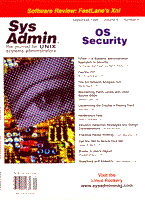
New MessagesSubject: The All Linux Office Author: Shannon Wyatt <swyatt@pnsinc.net>
I picked up the June issue of Sys Admin looking forward to the article by Bryan Andregg about the all Linux office. Unfortunately, I was very disappointed by this article. The article gives no examples of running an all Linux office, and it actually seems to promote the idea of Windows Terminal Server and Metaframe in the office. So, all the money you saved by going to Linux you spend on getting a Terminal Server, Metaframe, the server itself (these tend to be big and beefy), NT CALS, Terminal Server licenses and Metaframe Licenses. How is this an all Linux office? The conclusion of the article seems to be pulled from another article. The first sentence is “As you can see, Linux can provide regular users with a stable, easy-to-use, environment that offers all of the familiar features of other operating systems but runs more reliably.” That's a great statement; but unfortunately, the article provides no information to show this. The next sentence states, “Users also can run their favorite MS Windows programs without requiring additional workstation resources.” I'm sure that this refers to using terminal server, but what a waste of the terminal server. If my boss wants to run Quicken, I would give him a Microsoft system ($100-300 for the software) as opposed to spending thousands of dollars on a Metaframe server. If a lot of users need to run MS applications then maybe you should be running Windows on the desktop, and use Linux as the server. Assuming that the office is in a single location this would be much cheaper then running Terminal Server. The conclusion I got from this article is that you can't have an all Linux office. This article should have focused on the great desktop software that is availble for use with Linux, and how to use this software to create an all Linux office. I bought the magazine for this article alone. I wish that I could get my $4.95 back. Shannon Wyatt
Shannon, I would like to thank you for taking the time to write with your opinions about my article. I am sorry that you didn't find in it what you were looking for and that you felt misled by the title. Perhaps I can briefly explain why the article was written from the point of view that it was. I don't expect this to answer your criticisms, but maybe I can make you feel better about the $4.95 you spent [which by the way I am happy to refund to you in the form of a beer if I ever see you at a conference :)]. I was asked to write about the use of Linux as a desktop operating system and this led to the idea of writing about “The All Linux Office.” Working at Red Hat Software, where all desktops run Linux and all but a server or two run Linux, I felt qualified to write about a Linux office environment. The first thing that I need to point out is that there are tools missing from the Linux environment that sales, service, and marketing groups require to do business: presentation programs and contact databases are two examples. Now, it is true that the current office suites available offer the first, Applixware and StarOffice both come with graphical presentation tools; barring that I personally use LaTeX to prepare presentations. None of these applications import PowerPoint documents well, and these seem to be becoming an industry standard for communication. There are no heavy-weight contact management solutions available for Linux (though Oracle has one bundled in their Financials package, which will be available in October). By demonstrating that Metaframe and NT terminal server could be used to provide access to applications that were missing from the Linux landscape, I was trying to show how Linux could be used in an office environment where there were still unmet needs. I am sorry if this didn't come across this way. As a side note, I disagree that it is easier to provide personal Windows machines alongside Linux machines for a variety of reasons (duplicate resources, backups, administration costs), and I disagree that the absence of applications necessarily means reverting to a Windows-based desktop environment. While the title “The All Linux Office” may have been hype and a bit of universalizing, I don't see it that way. I think that we have to recognize that, while applications are missing, solutions need to be identified even if those solutions involve using software from the Dark Side. I have been thinking about a follow-up article (if SA is interested) about deploying Linux as the “Back Office” solution, which it sounds like you are more interested in (file serving, Intranet, mail handling, security) -- all of which Linux is perfectly suited for. If such an article is published, or even if I write one and it isn't, I would be happy to send it to you for review. Bryan C. Andregg (bandregg@redhat.com) |